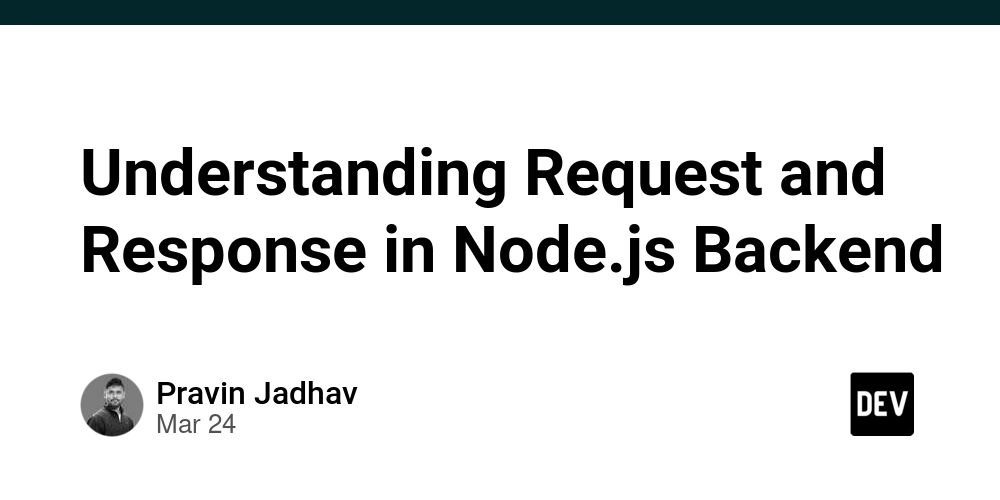Understanding Request and Response in Node.js Backend
In a Node.js backend, the request (req) and response (res) objects are used to handle communication between the client (browser, mobile app, etc.) and the server. These objects are part of the HTTP module or frameworks like Express.js. 1️⃣ What is a Request (req)? A request is sent by the client to the server asking for some action, like fetching data, submitting a form, or updating a resource. Request Components: ✔ Method – Defines the type of action (GET, POST, PUT, DELETE). ✔ URL/Path – The endpoint being requested (/users, /login, etc.). ✔ Headers – Extra information (Auth tokens, content type, etc.). ✔ Body – Data sent by the client (JSON, form data, etc.). ✔ Query Parameters – Additional data in the URL (?id=123&name=John). Example: Handling a Request in Express.js const express = require('express'); const app = express(); app.use(express.json()); // Middleware to parse JSON request body app.post('/login', (req, res) => { console.log(req.method); // "POST" console.log(req.url); // "/login" console.log(req.headers); // Headers sent by client console.log(req.body); // { "username": "JohnDoe", "password": "1234" } res.send('Login request received'); }); app.listen(3000, () => console.log('Server running on port 3000')); 2️⃣ What is a Response (res)? A response is the server's reply to a client request. It contains the data or message that the client expects. Response Components: ✔ Status Code – HTTP status (200 for success, 404 for not found, etc.). ✔ Headers – Extra response details (like content type). ✔ Body – The actual response data (JSON, HTML, etc.). Example: Sending a Response in Express.js app.get('/user', (req, res) => { const user = { id: 1, name: "John Doe" }; res.status(200) // Set status code to 200 (OK) .json(user); // Send JSON response }); 3️⃣ Request-Response Flow Example

In a Node.js backend, the request (req) and response (res) objects are used to handle communication between the client (browser, mobile app, etc.) and the server. These objects are part of the HTTP module or frameworks like Express.js.
1️⃣ What is a Request (req)?
A request is sent by the client to the server asking for some action, like fetching data, submitting a form, or updating a resource.
Request Components:
✔ Method – Defines the type of action (GET, POST, PUT, DELETE).
✔ URL/Path – The endpoint being requested (/users, /login, etc.).
✔ Headers – Extra information (Auth tokens, content type, etc.).
✔ Body – Data sent by the client (JSON, form data, etc.).
✔ Query Parameters – Additional data in the URL (?id=123&name=John).
Example: Handling a Request in Express.js
const express = require('express');
const app = express();
app.use(express.json()); // Middleware to parse JSON request body
app.post('/login', (req, res) => {
console.log(req.method); // "POST"
console.log(req.url); // "/login"
console.log(req.headers); // Headers sent by client
console.log(req.body); // { "username": "JohnDoe", "password": "1234" }
res.send('Login request received');
});
app.listen(3000, () => console.log('Server running on port 3000'));
2️⃣ What is a Response (res)?
A response is the server's reply to a client request. It contains the data or message that the client expects.
Response Components:
✔ Status Code – HTTP status (200 for success, 404 for not found, etc.).
✔ Headers – Extra response details (like content type).
✔ Body – The actual response data (JSON, HTML, etc.).
Example: Sending a Response in Express.js
app.get('/user', (req, res) => {
const user = { id: 1, name: "John Doe" };
res.status(200) // Set status code to 200 (OK)
.json(user); // Send JSON response
});
3️⃣ Request-Response Flow Example










































































































































































![[The AI Show Episode 142]: ChatGPT’s New Image Generator, Studio Ghibli Craze and Backlash, Gemini 2.5, OpenAI Academy, 4o Updates, Vibe Marketing & xAI Acquires X](https://www.marketingaiinstitute.com/hubfs/ep%20142%20cover.png)



























































































































![[FREE EBOOKS] The Kubernetes Bible, The Ultimate Linux Shell Scripting Guide & Four More Best Selling Titles](https://www.javacodegeeks.com/wp-content/uploads/2012/12/jcg-logo.jpg)



![From drop-out to software architect with Jason Lengstorf [Podcast #167]](https://cdn.hashnode.com/res/hashnode/image/upload/v1743796461357/f3d19cd7-e6f5-4d7c-8bfc-eb974bc8da68.png?#)






































































































.png?#)




.jpg?#)































_Christophe_Coat_Alamy.jpg?#)








































































































![Rapidus in Talks With Apple as It Accelerates Toward 2nm Chip Production [Report]](https://www.iclarified.com/images/news/96937/96937/96937-640.jpg)









































































































































